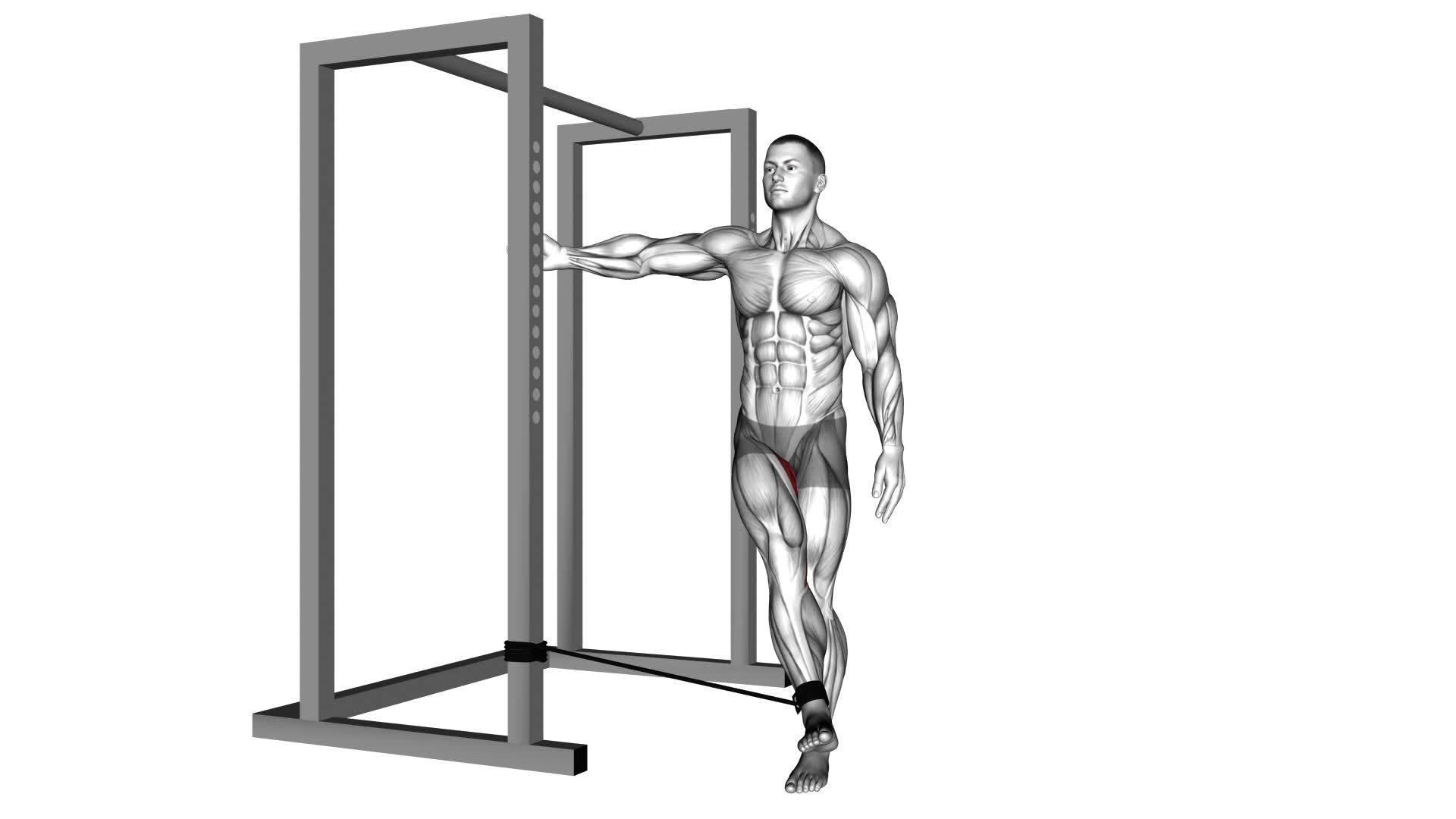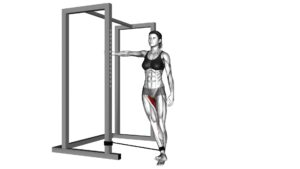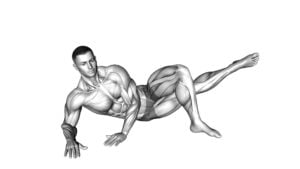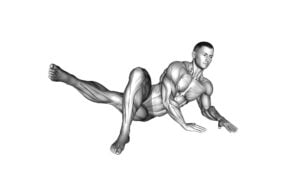Band Hip Adduction (male) – Video Exercise Guide & Tips

Are you looking to strengthen your hips and adductors? Look no further! In this video exercise guide, we'll show you the proper form and technique for band hip adduction exercises.
Watch This Exercise Video
With just a resistance band and a few minutes a day, you can target those hard-to-reach muscles and improve your overall lower body strength. Say goodbye to weak hips and hello to a more stable and powerful foundation.
Let's get started!
Key Takeaways
- Band hip adduction exercises target the adductors, muscles of the inner thighs.
- These exercises improve lower body stability and athletic performance.
- Engaging the core muscles is important for stability and effectiveness.
- Proper form and technique should be maintained to maximize results and prevent injury.
Benefits of Band Hip Adduction Exercises
You can experience numerous benefits by incorporating band hip adduction exercises into your workout routine. These exercises specifically target the muscles of your inner thighs, known as the adductors. By strengthening these muscles, you can improve your overall lower body stability and enhance your athletic performance.
One of the main benefits of band hip adduction exercises is the improvement in hip stability. Strong adductors help to stabilize the hip joint, reducing the risk of injuries such as hip impingement or instability. Additionally, these exercises can help to correct muscle imbalances, which can lead to better overall posture and alignment.
Band hip adduction exercises also offer variations and progressions that can challenge your muscles in different ways. For instance, you can increase the resistance of the band or change the angle of your body to target different areas of the adductors. Progressing from basic exercises to more advanced variations can help you continuously challenge your muscles and prevent plateaus in your training.
Equipment Needed for Band Hip Adduction
To perform band hip adduction exercises, you'll need specific equipment. One essential item you'll need is a resistance band. Resistance bands come in different levels of resistance, allowing you to adjust the intensity of your workout. They're lightweight, portable, and versatile, making them a popular choice for home workouts or on-the-go fitness routines.
When choosing a resistance band for hip adduction exercises, look for one with handles on both ends. These handles provide a secure grip and allow for a wide range of movements. The band should also be long enough to comfortably wrap around your thighs.
In addition to the resistance band, you may also want to have a yoga mat or a soft surface to perform the exercises on. This will provide cushioning and support for your body, reducing the risk of discomfort or injury.
Having a stable anchor point is crucial for band hip adduction exercises. You can use a sturdy piece of furniture, such as a table or a chair, or attach the band to a wall-mounted anchor point. Make sure the anchor point is secure and can withstand the tension of the band.
Proper Form and Technique for Band Hip Adduction
To perform the band hip adduction exercise with proper form and technique, it's important to focus on avoiding knee caving and engaging the inner thigh muscles. By maintaining proper alignment and avoiding inward collapse of the knees, you can effectively target the adductor muscles while minimizing strain on the knees.
Additionally, consciously contracting the inner thigh muscles throughout the movement will ensure maximum activation and effectiveness of the exercise.
Avoiding Knee Caving
Maintain proper alignment of your knees during Band Hip Adduction to avoid knee caving. This is crucial for avoiding knee injuries and ensuring that you're effectively strengthening your hip muscles.
When performing Band Hip Adduction, it's important to keep your knees in line with your toes and avoid them collapsing inward. To achieve this, engage your core and maintain a neutral spine position.
Keep your feet hip-width apart and press against the resistance band with controlled movements. Focus on squeezing your inner thigh muscles as you bring your legs together. Avoid any jerky or uncontrolled movements that can put unnecessary strain on your knees.
Engaging Inner Thigh Muscles
When engaging your inner thigh muscles for Band Hip Adduction, focus on maintaining proper form and technique to maximize the effectiveness of the exercise and minimize the risk of injury. Here are three key tips to help you engage your inner thigh muscles effectively:
- Keep your core engaged: By activating your core muscles, you provide stability and support to your pelvis and hips, allowing you to isolate and engage your inner thigh muscles more effectively.
- Squeeze your thighs together: Throughout the movement, focus on squeezing your thighs together as you bring your legs towards the midline of your body. This contraction will target your inner thigh muscles and help strengthen and tone them.
- Control the movement: Avoid using momentum or relying on other muscle groups to perform the exercise. Instead, focus on controlled movements, ensuring that it's your inner thigh muscles that are doing the work.
Variations and Progressions for Band Hip Adduction
Try incorporating these variations and progressions for band hip adduction into your workout routine to target your inner thigh muscles effectively. By adding variety to your exercises, you can challenge your muscles in different ways and prevent plateaus in your progress.
One variation you can try is the standing band hip adduction. Attach the band to a sturdy anchor point and stand sideways with your working leg facing the band. Place the band around your ankle, and keeping your leg straight, lift it out to the side against the resistance of the band. This variation adds an element of balance and stability to the exercise.
Another progression you can try is the seated band hip adduction. Sit on a bench or chair with the band wrapped around your ankles. Keep your knees bent at a 90-degree angle and press your legs outward against the resistance of the band. This variation targets your inner thigh muscles from a seated position, adding a different challenge to the exercise.
By incorporating these variations and progressions, you can continue to challenge and strengthen your inner thigh muscles.
Now, let's move on to the next section and discuss common mistakes to avoid in band hip adduction.
Common Mistakes to Avoid in Band Hip Adduction
To ensure proper form and maximize the effectiveness of your band hip adduction exercise, it's important to be aware of common mistakes that should be avoided. Here are three common mistakes to watch out for when performing band hip adduction:
- Poor knee alignment: One of the most common mistakes is allowing your knees to collapse inward during the exercise. This can put unnecessary stress on the knee joint and increase the risk of injury. To avoid this, make sure to keep your knees in line with your toes throughout the movement.
- Using too much tension: Another mistake is using too much tension in the band. While it's important to challenge yourself, using excessive tension can lead to poor form and decreased range of motion. Start with a moderate level of tension and gradually increase as you become more comfortable with the exercise.
- Not engaging the core: Many people forget to engage their core muscles while performing band hip adduction. This can lead to a loss of stability and decrease the effectiveness of the exercise. To avoid this, focus on keeping your core engaged throughout the movement by drawing your belly button towards your spine.
Tips for Maximizing Results in Band Hip Adduction
To maximize your results in band hip adduction, it's crucial to focus on proper form techniques. Make sure to maintain a stable position throughout the exercise, engaging your core and keeping your back straight.
Additionally, consider using different resistance band options to challenge your muscles and gradually increase the intensity.
Lastly, consistency is key, so aim for regular sessions and gradually increase the duration as you progress.
Proper Form Techniques
Achieve optimal results in band hip adduction by maintaining proper form throughout the exercise. To engage your glute muscles effectively and prevent hip injuries, keep the following tips in mind:
- Keep your core engaged and maintain a neutral spine throughout the movement.
- Place the resistance band just above your knees and ensure it's secure.
- Stand with your feet hip-width apart, toes pointing forward, and knees slightly bent.
By following these guidelines, you'll ensure that your glute muscles are properly activated and that you're performing the exercise safely and effectively.
Now, let's move on to the next section where we'll discuss the different resistance band options available for band hip adduction.
Resistance Band Options
Maximize your results in band hip adduction by choosing the right resistance band.
There are different types of resistance bands available for this exercise, and selecting the appropriate one can greatly impact your workout.
When it comes to resistance band types, you can choose from loop bands, tube bands, or flat bands.
Loop bands are perfect for targeting the hip adductor muscles, as they provide constant tension throughout the movement.
Tube bands, on the other hand, offer versatility and can be used for a variety of resistance band exercises.
Flat bands are ideal for beginners or individuals with limited mobility.
Experiment with different resistance band types to find the one that challenges you without compromising your form.
This will ensure that you maximize your results in band hip adduction.
Frequency and Duration
How often should you incorporate band hip adduction into your workout routine? The frequency and duration of your band hip adduction exercises can greatly impact your results.
Here are some tips for maximizing the effectiveness of this exercise:
- Consistency is key: Aim to perform band hip adduction exercises at least 2-3 times per week.
- Gradually increase intensity: Start with a lighter resistance band and gradually increase the tension as your muscles become stronger.
- Focus on proper form: Ensure that you're performing the exercise with correct technique and engaging the targeted muscles throughout the movement.
By incorporating band hip adduction into your workout routine with the right frequency and duration, you can maximize the results and strengthen your hip muscles effectively.
Remember to listen to your body and adjust the intensity as needed to avoid overexertion or injury.
Frequently Asked Questions
How Many Sets and Reps Should I Do for Band Hip Adduction Exercises?
To improve muscle strength, it's important to incorporate variations of band hip adduction exercises into your routine.
When deciding on the number of sets and reps, consider your fitness level and goals. As a general guideline, aim for 2-3 sets of 10-15 reps per exercise.
However, it's always best to consult with a fitness professional to tailor the sets and reps specifically to your needs.
Remember to use proper form and gradually increase the intensity as you progress.
Can Band Hip Adduction Exercises Help With Improving Balance and Stability?
Band hip adduction exercises can indeed help improve your balance and stability. By targeting the muscles in your hips and inner thighs, these exercises can enhance your core strength and prevent knee injuries.
Additionally, performing band hip adduction exercises regularly can also increase your hip flexibility and mobility, which is beneficial for athletic performance.
Incorporating these exercises into your workout routine can have a positive impact on your overall stability and coordination.
Is It Safe to Perform Band Hip Adduction Exercises if I Have a Knee Injury?
If you have a knee injury, it's important to take precautions when performing band hip adduction exercises. These exercises can put strain on the knees and may exacerbate your injury.
It's recommended to consult with a healthcare professional or physical therapist before attempting these exercises. They can provide guidance on alternative hip exercises that can help improve balance and stability without putting unnecessary stress on your injured knee.
Safety should always be a top priority when exercising with an injury.
Can Band Hip Adduction Exercises Help in Reducing Lower Back Pain?
Band hip adduction exercises can be beneficial for athletes in reducing lower back pain. By targeting the muscles in the hips and inner thighs, these exercises help to stabilize the pelvis and improve overall core strength.
To properly perform band hip adduction exercises, you should start by attaching a resistance band around your ankles and standing with your feet shoulder-width apart. Then, slowly squeeze your legs together against the resistance of the band, focusing on engaging your inner thigh muscles.
How Long Does It Typically Take to See Results From Band Hip Adduction Exercises?
Band hip adduction exercises are effective for targeting your inner thigh muscles and can provide results in a relatively short amount of time.
By consistently incorporating variations of band hip adduction exercises into your workout routine, you can start to see improvements in strength and muscle tone within a few weeks.
These exercises specifically target the adductor muscles in your hips, helping to improve stability and reduce the risk of injury.
Regular practice and proper form are key to achieving optimal results.
Conclusion
In conclusion, band hip adduction exercises can be highly beneficial for individuals looking to strengthen their hip muscles and improve their overall lower body stability. By using resistance bands, you can effectively target and engage the muscles responsible for hip adduction.
It's important to maintain proper form and technique while performing these exercises, and to gradually progress and challenge yourself as you become stronger. Avoid common mistakes and follow the provided tips to maximize your results and achieve optimal outcomes in band hip adduction.

Author
Years ago, the spark of my life’s passion ignited in my mind the moment I stepped into the local gym for the first time. The inaugural bead of perspiration, the initial endeavor, the very first surge of endorphins, and a sense of pride that washed over me post-workout marked the beginning of my deep-seated interest in strength sports, fitness, and sports nutrition. This very curiosity blossomed rapidly into a profound fascination, propelling me to earn a Master’s degree in Physical Education from the Academy of Physical Education in Krakow, followed by a Sports Manager diploma from the Jagiellonian University. My journey of growth led me to gain more specialized qualifications, such as being a certified personal trainer with a focus on sports dietetics, a lifeguard, and an instructor for wellness and corrective gymnastics. Theoretical knowledge paired seamlessly with practical experience, reinforcing my belief that the transformation of individuals under my guidance was also a reflection of my personal growth. This belief holds true even today. Each day, I strive to push the boundaries and explore new realms. These realms gently elevate me to greater heights. The unique combination of passion for my field and the continuous quest for growth fuels my drive to break new ground.







